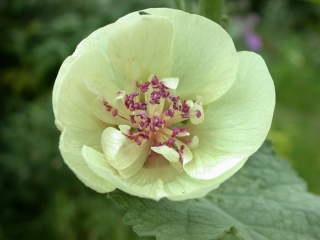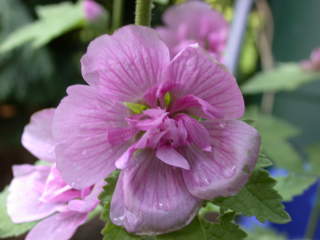The Malva Pages:
Malva 'Parkallee' &c
back to The Malva Pages
Malva 'Park Allee' gallery
Introduction
There is a group of related double-flowered mallows known as Malva
'Parkallee' (commonly anglicised as 'Park Allee'), Malva 'Parkfrieden'
and Malva 'Parkrondell' (sometimes anglicised as 'Park Rondel'). The
flowers of 'Park Allee' are cream-flowered; those of 'Parkfrieden'
apricot-flowered; and those of 'Parkrondell' a pale purple. There was a fourth
variety, Malva 'Parktraum', which may have been lost [1]. A more recent variety,
Malva
'Freedom', may be a pink-flowered sport of 'Parkallee'.
Classification
These plants have been variously referred to Malva, Malva
alcea, Malva sylvestris, Alcea, Alcea × Althaea,
Althaea × Alcea and Lavatera, and I have been told that they
are Kitaibelia vitifolia× Alcea rosea. The correct identity is not
perfectly clear, but it seems fairly certain that they are not correctly placed
in Lavatera or Malva. A paper which appears to describe their
breeding identifies them as Alcea (rosea × biennis)
× Althaea officinalis. (Alcea biennis is correctly known as
Alcea pallida.)
"Later we crossed the wild Althaea officinalis (in many
cases growing as a herb) with our Alcea hybrids. Their flowers are
intermediate-sized between the little-flowered Althaea and the
big-flowered Alcea. The colours of their flowers are intermediate, too.
They have pastel-coloured flowers. Their height is close to 2 metres. The most
important characteristic of them is rust-resistance and being of perennial.
They must be propagated in vegetative way because of their sterility." [2]
Confirmation of their identity from morphology is made difficult by their
being double (which means that we can't use the androecial morphology for
identification) and sterile (which means that we can't use the fruit
morphology).
The epicalyx is composed of ten fused triangular bracteoles, and the style
arms and stigmas are filiform. These features point at Alcea and
Althaea, and perhaps Kitaibelia, as genera possibly involved in
its parentage. The purple anthers are characteristic of Althaea section
Althaea (or Althaeastrum). However the plant as a whole is not a
close match for any species in that group. Hence it is deduced that it is a
hybrid with at least one parent within this group.
The tomentose, triangular, 3-lobed leaves recall Althaea officinalis,
rather than Althaea armeniaca or Althaea cannabina, so it is
likely that the first species is one of the parents. However it is clearly not
a variety of Althaea officinalis, differing from it as follows
- It is - was sold to me as - a subshrub, whereas Althaea officinalis
is a herbaceous perennial which overwinters as ground level resting buds (or
pleiocorms).
- The flowers are larger.
- The plant is taller (2m) which is larger than any Althaea
officinalis that I have seen.
Alcea rosea, which is also common in cultivation, is genetically
fairly close to Althaea, and has fertile double-flowered forms. Some
strains of cultivated hollyhock (e.g. 'Silver Puffs', 'Majorette') are of
hybrid origiin, the other parent being Althaea pallida. [2]
Origin
It appears that these plants were originally raised in Hungary, and
propagated in East Germany, from whence they were released into the
horticultural trade.
Description
 "Malva" 'Park Allee'
appears to be a subshrub, producing new shoots in the spring from near the base
of the old stems. This differs from both Althaea officinalis, with its
ground level resting buds, and Alcea rosea, which typically produces new
stems at ground level; nor is it intermediate between the two species. The
stems are initially green and softly hairy, in which they match Althaea
officinalis; however they are thicker, but less strong, in which they agree
with Alcea rosea. They become glabrous in age.
"Malva" 'Park Allee'
appears to be a subshrub, producing new shoots in the spring from near the base
of the old stems. This differs from both Althaea officinalis, with its
ground level resting buds, and Alcea rosea, which typically produces new
stems at ground level; nor is it intermediate between the two species. The
stems are initially green and softly hairy, in which they match Althaea
officinalis; however they are thicker, but less strong, in which they agree
with Alcea rosea. They become glabrous in age.
The leaves are similiar to those of Althaea officinalis in being
tomentose, roughly triangular in outline, with three forward pointing lobes.
However they are thicker, in which they are similar to Alcea rosea.
The flowers have an epicalyx of 10 fused bracteoles. The epicalyx is
initially valvate in aestivation, but is less persistently so than Alcea
rosea. (Lavatera thuringiaca and Malva wigandii also have
epicalyxes valvate early in aestivation). The bracteoles are circa 1 cm long.
The calyx and corolla are 5-merous. The sepals are circa 1.5 cm long, and
tomentose. The petals are circa 4 cm long, and cream in colour. They overlap
spirally and broadly to form a corolla with a near circular outline. The
androecium shows a continuum from petaloid staminodes differing from the petals
only in being smaller and narrower, through similar staminodes bearing anthers
at their apices and ligulate, anther-bearing staminodes to normal stamens; the
full range is not always shown in every flower. These structures are borne in 5
distinct columns. (Malope trifida also bears stamens in 5 distinct
columns.) The gynoecium has 15-20 style arms, with filiform stigmas. The ovary,
as seen after the corolla, etc., has fallen away, is shallowly 5-lobed. It
seems to me that each lobe is composed of several locules. This could be
interpreted as intermediate between the verticillate schizocarps of most
mallows, and the capitate schizocarps of Kitaibelia vitifolia and a few
other species.
 "Malva" 'Park Rondell'
has pale purple flowers. Its staminodes uniformly lack anthers, and are all
ligulate.
"Malva" 'Park Rondell'
has pale purple flowers. Its staminodes uniformly lack anthers, and are all
ligulate.
Sports do occur. I have seen a photograph of a 'Parkrondel'-like sport of
'Parkallee'. I have also seen similar sports, affecting a few petals, on my own
plants of 'Parkallee'.
References
- J.L. Sharman, pers. comm.
- Z. Kováts and K. Karip-Szabö, The Use of
Hungarian Wild Plants in the Ornamental Plant Breeding, Acta Hort.612: 172-173
Feedback
If you have found any errors on this page, or have any further information
about Malva 'Park Allee' or similar cultivars then please contact me at
botany@malvaceae.info.
back to The Malva Pages
Malva 'Park Allee' gallery
© 2004, 2005, 2007 Stewart Robert Hinsley
 "Malva" 'Park Allee'
appears to be a subshrub, producing new shoots in the spring from near the base
of the old stems. This differs from both Althaea officinalis, with its
ground level resting buds, and Alcea rosea, which typically produces new
stems at ground level; nor is it intermediate between the two species. The
stems are initially green and softly hairy, in which they match Althaea
officinalis; however they are thicker, but less strong, in which they agree
with Alcea rosea. They become glabrous in age.
"Malva" 'Park Allee'
appears to be a subshrub, producing new shoots in the spring from near the base
of the old stems. This differs from both Althaea officinalis, with its
ground level resting buds, and Alcea rosea, which typically produces new
stems at ground level; nor is it intermediate between the two species. The
stems are initially green and softly hairy, in which they match Althaea
officinalis; however they are thicker, but less strong, in which they agree
with Alcea rosea. They become glabrous in age. "Malva" 'Park Rondell'
has pale purple flowers. Its staminodes uniformly lack anthers, and are all
ligulate.
"Malva" 'Park Rondell'
has pale purple flowers. Its staminodes uniformly lack anthers, and are all
ligulate.